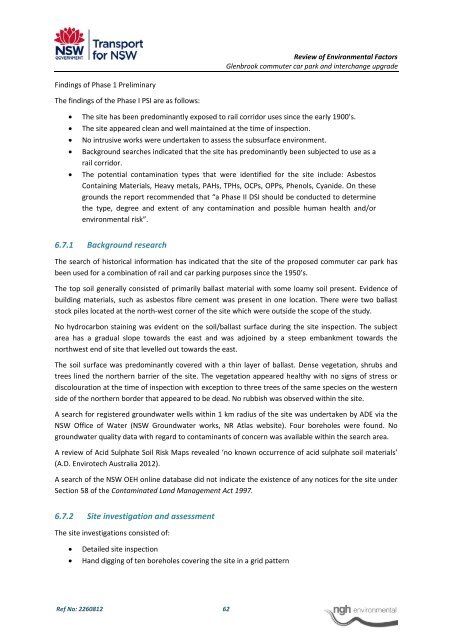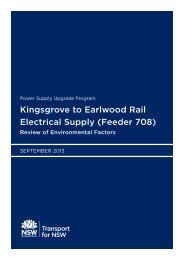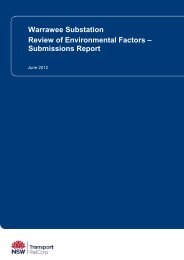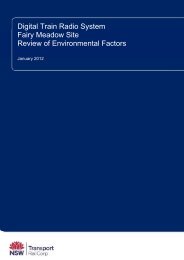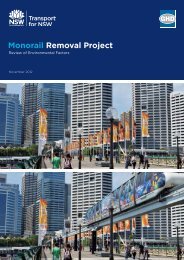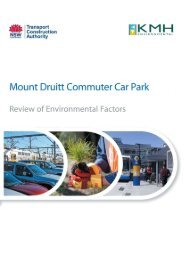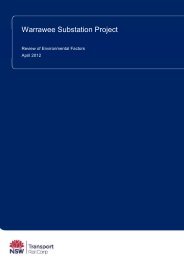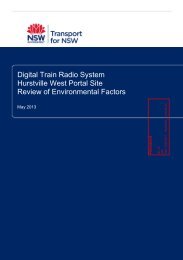Glenbrook Sation REF (pdf 3.15MB) - Transport for NSW - NSW ...
Glenbrook Sation REF (pdf 3.15MB) - Transport for NSW - NSW ...
Glenbrook Sation REF (pdf 3.15MB) - Transport for NSW - NSW ...
- No tags were found...
You also want an ePaper? Increase the reach of your titles
YUMPU automatically turns print PDFs into web optimized ePapers that Google loves.
Review of Environmental Factors<strong>Glenbrook</strong> commuter car park and interchange upgradeFindings of Phase 1 PreliminaryThe findings of the Phase I PSI are as follows:• The site has been predominantly exposed to rail corridor uses since the early 1900’s.• The site appeared clean and well maintained at the time of inspection.• No intrusive works were undertaken to assess the subsurface environment.• Background searches indicated that the site has predominantly been subjected to use as arail corridor.• The potential contamination types that were identified <strong>for</strong> the site include: AsbestosContaining Materials, Heavy metals, PAHs, TPHs, OCPs, OPPs, Phenols, Cyanide. On thesegrounds the report recommended that “a Phase II DSI should be conducted to determinethe type, degree and extent of any contamination and possible human health and/orenvironmental risk”.6.7.1 Background researchThe search of historical in<strong>for</strong>mation has indicated that the site of the proposed commuter car park hasbeen used <strong>for</strong> a combination of rail and car parking purposes since the 1950’s.The top soil generally consisted of primarily ballast material with some loamy soil present. Evidence ofbuilding materials, such as asbestos fibre cement was present in one location. There were two ballaststock piles located at the north‐west corner of the site which were outside the scope of the study.No hydrocarbon staining was evident on the soil/ballast surface during the site inspection. The subjectarea has a gradual slope towards the east and was adjoined by a steep embankment towards thenorthwest end of site that levelled out towards the east.The soil surface was predominantly covered with a thin layer of ballast. Dense vegetation, shrubs andtrees lined the northern barrier of the site. The vegetation appeared healthy with no signs of stress ordiscolouration at the time of inspection with exception to three trees of the same species on the westernside of the northern border that appeared to be dead. No rubbish was observed within the site.A search <strong>for</strong> registered groundwater wells within 1 km radius of the site was undertaken by ADE via the<strong>NSW</strong> Office of Water (<strong>NSW</strong> Groundwater works, NR Atlas website). Four boreholes were found. Nogroundwater quality data with regard to contaminants of concern was available within the search area.A review of Acid Sulphate Soil Risk Maps revealed ‘no known occurrence of acid sulphate soil materials’(A.D. Envirotech Australia 2012).A search of the <strong>NSW</strong> OEH online database did not indicate the existence of any notices <strong>for</strong> the site underSection 58 of the Contaminated Land Management Act 1997.6.7.2 Site investigation and assessmentThe site investigations consisted of:• Detailed site inspection• Hand digging of ten boreholes covering the site in a grid patternRef No: 2260812 62


